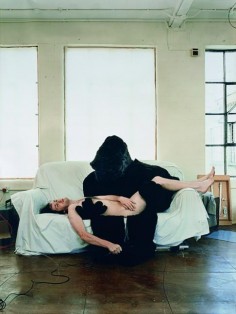ANGUS FAIRHURST
Pietà
source: mleuvenbe
Fairhurst was one of the most influential members of the group of artists who became known as the ‘Young British Artists’ (YBA) in the late ‘80s. They were associated with London’s Goldsmiths College and set the tone for contemporary art in the United Kingdom for two decades.
The exhibition at M presents examples from his entire oeuvre, which encompasses various media. Paintings, performance, animation, photography, video, sculpture, music, prints, drawings and collages demonstrate the versatility of an artist who transcends any particular category. His works touch on subjects such as desire, sex, death, the emptiness of gestures or the power of advertising.
A careful examination of the society of the spectacle
Repetition and opposition form the core of his artistic approach. Just as monumental figures such as Samuel Beckett and Bruce Nauman did, Fairhurst discusses the absurdity of life: we are born, we wake up, we sleep and we are destined to die. Any possible meaning is confronted with its own caricature, its own comedy.
His work deals with a number of themes; Fairhurst makes us reflect on our current society of the spectacle with a consistently distinctive, absurd sense of humour.
He extracts images and text from both colourful, seductive advertisements and fashion magazines, which he then combines into unique collages, so that only conceptual apparitions remain.
The comic icon of the ‘gorilla’
Fairhurst was a great lover of nature and the interplay between nature and art is a recurring theme throughout his oeuvre. He was fascinated by the ‘gorilla’ as a comic icon. His early cartoons depict humans and animals engaged in unlikely household or comic situations.
The 1995 video ‘A Cheap and Ill-Fitting Gorilla Suit’ will be shown in the M auditorium. In the video, a figure jumps up and down in a gorilla suit. The stuffing begins to fall out, until the suit eventually falls apart and the artist himself is revealed, naked. Fairhurst also created various monumental bronze gorillas, such as ‘A Couple of Differences Between Thinking and Feeling II’ (2003).
The exhibition is an Arnolfini-exhibition, and the curator is Tom Trevor, the director of Arnolfini; it is organised in co-operation with M, The Estate of Angus Fairhurst and Sadie Coles HQ, London.
.
.
.
.
.
.
.
source: invaluable
Angus Fairhurst (4 October 1966 – 29 March 2008) was born in Penbury, Kent, England in 1966 and received a fine arts degree from Goldsmith College in London in 1989. In March 2008 he committed suicide at the age of 41. Throughout his life he worked with a variety of media such as collage, sculpture, painting, installation and performance, and was a member of the group known as Young British Artists, or Y.B.A.’s, who were internationally known for their crude and vulgar works in London throughout the 1990s. He did not have a signature style and was particularly known for his absurdist sense of humor, often using visual distortion and practical jokes.
In 1991 he did a piece in which he networked together the phones of leading London art galleries so that they could only talk to each other, suggesting that the art world is often only interested in speaking to itself. One of his works from 2004 titled “Undone” is a nine-foot-long realistic bronze sculpture of a peeled banana. Another bronze sculpture piece titled “The Birth of Consistency” features the representation of a gorilla gazing at himself in a mirrored pool. He often created layered collages composed of words and images found in advertisements of subways. Another member of the Y.B.A and former classmate of Fairhurst was Damien Hirst. Fairhurst had a lower profile than the notorious Hirst, but his paintings, sculptures and installations were exhibited around the world.


